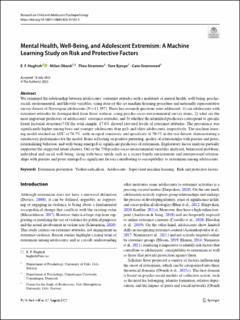| dc.description.abstract | We examined the relationship between adolescents’ extremist attitudes with a multitude of mental health, well-being, psycho-
social, environmental, and lifestyle variables, using state-of-the-art machine learning procedure and nationally representative
survey dataset of Norwegian adolescents (N = 11,397). Three key research questions were addressed: 1) can adolescents with
extremist attitudes be distinguished from those without, using psycho-socio-environmental survey items, 2) what are the
most important predictors of adolescents’ extremist attitudes, and 3) whether the identified predictors correspond to specific
latent factorial structures? Of the total sample, 17.6% showed elevated levels of extremist attitudes. The prevalence was
significantly higher among boys and younger adolescents than girls and older adolescents, respectively. The machine learn-
ing model reached an AUC of 76.7%, with an equal sensitivity and specificity of 70.5% in the test dataset, demonstrating a
satisfactory performance for the model. Items reflecting on positive parenting, quality of relationships with parents and peers,
externalizing behavior, and well-being emerged as significant predictors of extremism. Exploratory factor analysis partially
supported the suggested latent clusters. Out of the 550 psycho-socio-environmental variables analyzed, behavioral problems,
individual and social well-being, along with basic needs such as a secure family environment and interpersonal relation-
ships with parents and peers emerged as significant factors contributing to susceptibility to extremism among adolescents. | en_US |

